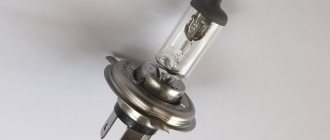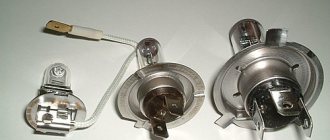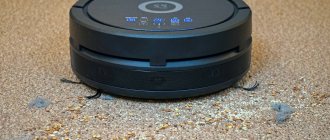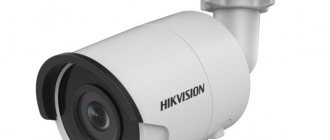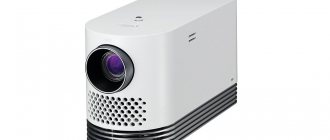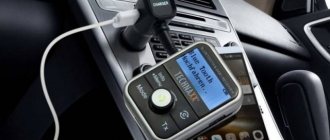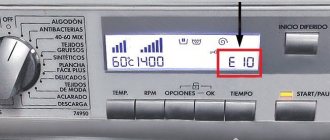Price
The cost of premium H4 low beam halogen lamps differs from standard Philips and Osram lamps by 4-6 times. Usually the price is in the range of 1300-1700 rubles. per set. A standard H4 halogen installed by the manufacturer costs 150-200 rubles. a piece.
| Name | Price |
| 1. PIAA Hyper Arros +120% H4 | 1300 rub/set |
| 2. Koito Whitebeam III Premium H4 | 1650 rub/set |
| 3. Fukurou F1 H4 | 1600 rub/set |
| 4. Philips Racing Vision +150 H4 | 1200 rub/set |
| 5. Osram Night Breaker Laser +150 H4 | 1800 rub/set |
| 6. General Electric Megalight Ultra +150 H4 | 1350 RUR/set |
| 7. Bosch Gigalight plus 120 H4 | 1100 rub/set |
| 8. Champion +90 H4 | 300 rub/set |
| 9. Osram Original H4 | 320 RUR/set |
| 10. GSL Standard +30% H4 | 200 rub/set |
Lamps without packaging, arrangement as in the table.
Recommendations
When choosing a car lamp for low beam, it is recommended to follow these simple rules:
- You should carefully study the manufacturer's instructions. It is important to be familiar with all instructions and advice. In particular, sometimes there is a ban on the use of one or another model on public roads in Western European countries.
- It is important to consider, in addition to the popularity of the manufacturer, also the technical characteristics of the lamp.
- You should not chase power when buying the brightest car lamp. First of all, the light should be comfortable for the driver.
- When choosing a powerful lamp, you need to make sure that the car's electrical network can withstand the appropriate load.
Material on the topic Das Auto in Russian style
Number of lumens
Preheat the samples for 5 minutes until the light flux stabilizes. A photometric sphere is used to measure light. We use Osram Original H4 as a sample of a standard lamp; all others will be compared with it.
| Name | Near | Further | Difference |
| 1. PIAA Hyper Arros +120% H4 | 1080lm | 1650 lm | +3% / 0% |
| 2. Koito Whitebeam III Premium H4 | 960 lm | 1600 lm | -9% / -4% |
| 3. Fukurou F1 H4 | 1390 lm | 2050 lm | +32% / +23% |
| 4. Philips Racing Vision +150 H4 | 1200 lm | 1640 lm | +14% / -2% |
| 5. Osram Night Breaker Laser +150 H4 | 1150 lm | 1610 lm | +10% / +4% |
| 6. General Electric Megalight Ultra +150 H4 | 1210 lm | 1700 lm | +15% / +2% |
| 7. Bosch Gigalight plus 120 H4 | 1120 lm | 1650 lm | +7% / 0% |
| 8. Champion +90 H4 | 780 lm | 1470 lm | -25% / -12% |
| 9. Osram Original H4 | 1050 lm | 1670 lm | — |
| 10. GSL Standard +30% H4 | 1080 lm | 1690 lm | +3%/ 0% |
The Japanese Fukurou F1 are in the lead with a short-range result of +32%, a long-range result of +23%. The rest have a maximum of +15% on low beam, +4% on high beam. The luminous flux is practically no different from standard halogen bulbs, so there cannot be any +150%.
How to start a car with a dead battery?
Published: 01/13/2019
Spread the love
Spread the love Towing, pushing or borrowing electricity - how to start a car with a dead batteryContents1 Towing, pushing or borrowing electricity - how to start a car with a dead battery1.1 Problems with starting hybrids1.2 How to start a car in an emergency1.2.1 We are in VK When after On a cold night you are running out of battery power, it is better not to use traditional starting methods. Modern...
How to start a car with a dead battery? Read completely "
Power
To measure power consumption, set the voltage on the lamp to 13.2 Volts.
The maximum power at low beam differs by +10% from the standard one. At a distance it differs only by +2%. Tests show that the power is practically the same as the standard model. Some car enthusiasts are afraid that expensive models will heat up the headlight more, and the reflector or lens will become cloudy. There will be no consequences, the service life of the headlight will remain the same.
| Name | Near | Further |
| 1. PIAA Hyper Arros +120% H4 | 72w | 78w |
| 2. Koito Whitebeam III Premium H4 | 70w | 74w |
| 3. Fukurou F1 H4 | 71w | 77w |
| 4. Philips Racing Vision +150 H4 | 71w | 77w |
| 5. Osram Night Breaker Laser +150 H4 | 70w | 77w |
| 6. General Electric Megalight Ultra +150 H4 | 65w | 77w |
| 7. Bosch Gigalight plus 120 H4 | 65w | 68w |
| 8. Champion +90 H4 | 65w | 76w |
| 9. Osram Original H4 | 65w | 76w |
| 10. GSL Standard +30% H4 | 69w | 76w |
Colorful temperature
Expensive samples promise a color temperature closer to white light. The standard is 3200K, approximately the same as conventional incandescent lamps. To produce white light you need at least 4000 Kelvin. The Koito Whitebeam III Premium has the whitest light, only 3900K instead of the stated 4500K. For the rest, it practically does not differ from the standard halogen, it is in the range of 3400K - 3600K.
| Name | Stated | Near | Further |
| 1. PIAA Hyper Arros +120% | 3900K | 3400K | 3500K |
| 2. Koito Whitebeam III Premium | 4500K | 3900K | 4070K |
| 3. Fukurou F1 | 3300K | 3300K | 3350K |
| 4. Philips Racing Vision +150 | 3500K | 3600K | 3650K |
| 5. Osram Night Breaker Laser +150 | 3900K | 3500K | 3800K |
| 6. General Electric Megalight Ultra +150 | — | 3400K | 3600K |
| 7. Bosch Gigalight plus 120 | — | 3400K | 3300K |
| 8. Champion +90 | — | 3250K | 3600K |
| 9. Osram Original | 3200K | 3170K | 3190K |
| 10. GSL Standard +30% | — | 3100K | 3200K |
Which car lamps to buy
When choosing certain lamps, it is necessary to take into account their power (as a rule, this value is standard and is 55 W), the value of the luminous flux, the temperature of the light and the type of base.
You should not buy a lamp that is significantly more powerful than the one that has burned out. You will find the relevant information in the manual or reference literature for your car.
If a lamp (or one of its modes) in one headlight fails, it is advisable to buy a pair of new ones and replace them simultaneously in both headlights. This will ensure they have the same glow and approximately the same service life. You will also find information about the type of base in the documentation for the machine. Let's take a closer look at color temperature and flux.
Color temperature and luminous flux
When choosing lamps, it is also worth considering their color temperature. After all, it directly depends on the type and power of the light bulbs. For the human eye, the most optimal color temperature is in the range of 4000...6500 Kelvin. This range corresponds to white daylight emitted by artificial or natural sources. For example, a cool white fluorescent lamp emits light with a temperature of 4000 K. And midday white light has a temperature of 6500 K.
However, the lamps mentioned above are not always appropriate. If there is poor visibility or fog outside, it is better to use bulbs with a lower temperature (for example, 3000 K and below). For reference: a 200 W incandescent lamp emits light with a temperature of 3000 K. Based on this, the best option would be the following choice:
- for fog lights it is better to choose light sources with a temperature in the range of 3000...3500 K;
- for conventional headlights, it is better to buy lamps with a temperature of 4000 K and above.
Lamps with temperatures in the range of 4200...4500 K provide optimal white light. If the temperature is below 3500 K, then a yellowish tint is already noticeable. And if the temperature is 5000 K and higher, then you will be able to observe a bluish tint.
When purchasing a lamp, pay attention to the luminous flux value. In accordance with the current state standard GOST R 41.37-99 (UNECE Rules No. 37), for lamp types h7 it should be 1350 lumens for 6-volt lamps, and 1550 lumens for 12-volt lamps . This requirement is due to compliance with safety requirements for both the driver of the direct vehicle and the drivers of oncoming cars.
Don't buy too powerful lamps! The rated power value is indicated in the vehicle documentation. Otherwise (if the light bulb is very powerful), there is a risk of damage to the reflector due to its constant overheating. And this means replacing the entire headlight, which naturally won’t be cheap.
Manufacturers
Currently, there are a large number of brands and manufacturers on the market. Not taking into account little-known Chinese and other brands, the most common are the following: OSRAM, Philips, BOSCH, Narva, Mayak. The choice between them should be made based on standard indicators - the presence of the desired light bulb model in their line, the warranty period, the originality of the product, the price-quality ratio.
Employees of the reputable publishing house “Behind the Wheel” conducted real tests of lamps from the manufacturers mentioned above. The tests were carried out on a Chevrolet Aveo car with headlights that had been in use for one and a half years. The luminous flux value was measured using the Ecolight-02 device separately for the right and left headlights. The test results are summarized in a table. The letter "L" means left headlight, and "P" means right headlight.
| Manufacturers | Distance [m] and luminous flux value [lx] | |||||||||||||
| 10 | 20 | 30 | 40 | 50 | 60 | 70 | ||||||||
| L | P | L | P | L | P | L | P | L | P | L | P | L | P | |
| OSRAM | 134 | 188 | 17,7 | 42,4 | 5,25 | 14,5 | 2,24 | 8,08 | 1,11 | 5,05 | 0,33 | 3,05 | — | 1,8 |
| "Lighthouse" | 127 | 173 | 23,6 | 38,3 | 6,14 | 16 | 2,56 | 9,05 | 1,27 | 6,06 | 0,64 | 3,6 | 0,3 | 2,35 |
| Philips (+30%) | 110 | 188 | 12,4 | 33,3 | 3,59 | 13,6 | 1,23 | 7,64 | 0,54 | 4,84 | — | 2,8 | — | 1,57 |
| BOSCH | 94,3 | 152 | 14,8 | 34,4 | 3,13 | 13,1 | 1,25 | 6,37 | 0,65 | 3,89 | — | 2,3 | — | 1,35 |
| Narva | 91,5 | 177 | 9,34 | 30,7 | 2,24 | 10,3 | 0,7 | 4,81 | — | 2,83 | — | 1,27 | — | 0,46 |
| Standard lamps | 78,3 | 102 | 9,03 | 21,3 | 2,05 | 7,03 | 0,32 | 3,6 | — | 1,73 | — | 0,69 | — | 0,17 |
| LED | 64,3 | 89,6 | 17,7 | 24,9 | 8,65 | 10,4 | 4,98 | 4,01 | 3,14 | 3,86 | 2,17 | 2,58 | 1,6 | 1,78 |
The table also shows values for light-emitting diode (LED) lamps that have been inserted into headlights designed for standard halogen lamps. As can be seen from the tests performed and the results presented, their luminous flux indicators are extremely low. Therefore, we repeat the above information that LED lamps can only be used with appropriate headlights!
Description of measuring points
To compare different light sources, GOST is used, which regulates the main points for measuring illumination according to a table posted on the wall. The number in the designation of a point is equal to its distance from the car. The letters L and R indicate location, left and right. Main measuring points according to GOST: 75R and 50R - illumination of the right side of the road at a distance of 75 and 50 meters; B50L - is responsible for the level of blinding of the driver of an oncoming car; long-distance is measured at the center of the table and is located in the center of the lane; The axial luminous intensity determines the level of illumination in front of the car.
Comparison of illumination according to GOST
The samples are installed in a new headlight from Volkswagen Polo with a socket, then we measure the illumination of the control points. The voltage is 13.2 Volts on the lamp, not the power supply. This compensates for the reduction in voltage in the power wires.
| Name | 50L | 50R | 75R | Axial | Further |
| 1. PIAA Hyper Arros +120% | 8,2 | 26,1 | 26 | 25,6 | 33 |
| 2. Koito Whitebeam III Premium | 5,6 | 26,9 | 25,7 | 26,7 | 40,8 |
| 3. Fukurou F1 | 11,2 | 41,6 | 42,1 | 44,6 | 53,4 |
| 4. Philips Racing Vision +150 | 12 | 40,1 | 39,8 | 43,3 | 40,1 |
| 5. Osram Night Breaker Laser +150 | 11,8 | 38,2 | 40,8 | 38,4 | 31,5 |
| 6. General Electric Megalight Ultra +150 | 11,8 | 32,3 | 36,1 | 32,6 | 33,4 |
| 7. Bosch Gigalight plus 120 | 11,9 | 29,5 | 32,5 | 30 | 32,5 |
| 8. Champion +90 | 6,3 | 7,7 | 10 | 8 | 27,3 |
| 9. Osram Original | 10,5 | 27,3 | 30,3 | 28 | 33,2 |
| 10. GSL Standard +30% | 7,8 | 38,6 | 35,1 | 40,6 | 31,1 |
The results are surprising, even Philips and Osram significantly overestimate the real characteristics or hide them behind advertising figures +120%, +150%.
Since the luminous flux is almost the same (except for Fukurou F1) with a standard halogen lamp, you can change the illumination on the road in one way. The near spiral is moved closer to the base, the illumination in the center increases, but the illumination in the near zone decreases.
How to transport skis and snowboards by car
Published: 01/13/2019
Spread the love
Spread the love Transporting a snowboard and skis on the roof of a car Contents 1 Transporting a snowboard and skis on the roof of a car 1.1 How to transport skis? 1.2 This is worth remembering 1.2.1 We at VK We can easily travel with skis or a snowboard by car. The key is to transport the equipment in a way that does not endanger others - not just in the car, but...
How to transport skis and snowboards by car Read more »
Life time
The service life of most premium H4 lamps is much lower than standard ones. I found only 4 specifications specified by the manufacturers. Other brands do not provide such information.
| Name | Near | Further |
| Osram Original | 900h. | 500h. |
| Fukurou F1 | 500h. | 400h. |
| Philips Racing Vision +150 | 200h. | 200h |
| Osram Night Breaker Laser +150 | 240h. | 160h. |
The service life of the Japanese Fukurou F1 H4 is on average 2-3 times higher than the expensive Philips and Osram models on low and high beam. I don’t understand why the service life of premium Philips and Osrams is so low, the power is almost the same as the standard ones, and the color temperature changes due to the blue filter. I assume that the service life is artificially underestimated in order to buy more often.
Test results
The leader in testing in terms of luminous flux and illumination on the road was the Japanese Fukurou F1 halogen lamps. Unfortunately, the world-famous brands Philips, Osram, Koito, PIAA, Bosch, General Electric are deceiving their customers. They do not provide the promised improvement; illumination can only increase by 34% for samples No. 3,4,5.
As a result, we get an improvement in illumination by a maximum of 25% -34%, and the cost is 400% -600% higher. Taking into account the short service life, 2-3 times less than the standard one, the operating cost is quite expensive.
Some car enthusiasts practically do not notice the difference in the lighting of standard and premium lamps. Some people convince themselves of a significant improvement in the illumination of the road surface. Usually depends on age, color vision acuity, and the driver’s visual condition.
Author: Sergey Kazantsev
cvet_diod
Apotheosis of LED sculptures: 2800 rub.
a piece. Although they look good in the window. By the way, each such product is equipped with a fan: the luminous semiconductors heat up ungodly. But we did not carry out endurance tests: it is enough that the useless product was given the honor of going to the Apotheosis of LED sculptures test site: 2800 rubles. a piece. Although they look good in the window. By the way, each such product is equipped with a fan: the luminous semiconductors heat up ungodly. But we did not carry out endurance tests: it is enough that the useless product was given the honor of going to the test site
Apotheosis of LED sculptures: 2800 rub. a piece. Although they look good in the window. By the way, each such product is equipped with a fan: the luminous semiconductors heat up ungodly. But we did not carry out endurance tests: it is enough that the useless product was given the honor of going to the test site
In general, there is no point in buying such trinkets. Even if their light output reaches lamp levels, such “parts of light” will still be a foreign body for an ordinary headlight.
The use of LEDs in headlights designed for incandescent lamps inevitably worsens illumination
The cost of such “light bulbs” is from 360 to 1450 rubles. a piece. We foresaw the result of the tests, but still bought them specifically in order to say again: do not waste your money on such products! They cannot work in ordinary headlights, either theoretically or practically.
The cost of such “light bulbs” is from 360 to 1450 rubles. a piece. We foresaw the result of the tests, but still bought them specifically in order to say again: do not waste your money on such products! They cannot work in ordinary headlights, either theoretically or practically.
The cost of such “light bulbs” is from 360 to 1450 rubles. a piece. We foresaw the result of the tests, but still bought them specifically in order to say again: do not waste your money on such products! They cannot work in ordinary headlights, either theoretically or practically.
